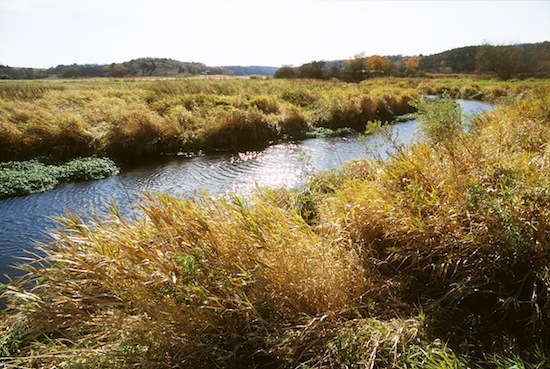Perennial energy crops could provide environmental benefits

Agricultural buffers, like the one placed adjacent to Black Earth Creek on a farm in western Dane County, could filter runoff, sequester greenhouse gases, and provide habitat for beneficial insects while also providing feedstocks for bioenergy.
Photo: Wolfgang Hoffmann, College of Agricultural and Life Sciences
Rows of corn and soybeans cover rolling hills, stitched together by creeks and woodlands that compose southwest Wisconsin’s agricultural patchwork. These complex landscapes provide clean water, wildlife habitat and climate benefits, yet, historically their value has been measured in just one way: bushels per acre.
“Right now, we just pay farmers to produce commodities,” says Tim Meehan, an associate scientist with the Great Lakes Bioenergy Research Center. “It would be nice if we paid them to produce clean water and other ecosystem services as well.”
In a study published Nov. 6 in PLOS ONE, a team of University of Wisconsin–Madison researchers used modeling tools to explore how switching land from growing an annual corn crop to growing perennial grasses for bioenergy would impact farmer income, energy production, and environmental benefits like greenhouse gas mitigation, biodiversity support and water quality.
Planting perennial crops such as switchgrass near creeks increased greenhouse gas mitigation, water quality, beneficial insects and energy production, though it decreased total net income of farms in the study area by roughly $30 million.
“When we’re asking people to plant perennials [instead of corn], we’re dealing with a considerable tradeoff,” says Meehan, the study’s lead author. “If we expect perennial energy crops to take hold, we have to create a system where people are compensated for those tradeoffs.”
So what is the value of the environmental benefits associated with perennial crops? According to the study, it depends.
Using current conservation program and environmental market value, these beneficial environmental outcomes in the study area are valued at a mere $3 million, which is much lower than the $30 million opportunity cost to farmers for switching their land to perennial production.
“If we expect perennial energy crops to take hold, we have to create a system where people are compensated for those tradeoffs.”
Tim Meehan
However, when considering the potential value of extra biofuels produced from the perennial crops ($11 million), the phosphorous pollution that could be avoided ($27 million) and the current market cost of carbon ($5 million), the value of these environmental benefits is $43 million, which far exceeds the opportunity cost.
That’s a $40 million disconnect between the social value of these environmental services and the amount of money that producers might be compensated.
“This research can be a starting point for a richer public dialogue on whether new policy is needed to fully value the environmental benefits of growing energy crops and making other land use changes,” says Gary Radloff, director of Midwest energy policy analysis at the Wisconsin Energy Institute. “This paper gives us deeper analysis to make a case for new public policy options in this area.”
While the magnitude of the hit to farmer income in these scenarios surprised Meehan, the modeling also revealed some unexpected good news. Across the study area, there are so called “hotspots” where the switch to perennials can provide a substantial benefit for a lower cost.
“There are certain places where you can make the switch, get a lot of ecosystem services, but won’t lose a lot of money,” Meehan says. “We wanted to find the spots where these tradeoffs are low, where you get more bang for you buck.”
And that’s exactly what the research team hopes to do. In a follow-up project, they are developing a web-based tool that anyone can use to predict how land use decisions will impact a variety of outcomes, including biofuel production, farmer income and environmental services.
“Everyone thinks about agricultural land use, and its consequences, differently,” says Meehan. “Some pay more attention to outcomes that benefit individuals, like income, while others focus on broader outcomes for the general public, like water quality. We are trying to build knowledge and tools for people to see tradeoffs from many different angles.”




